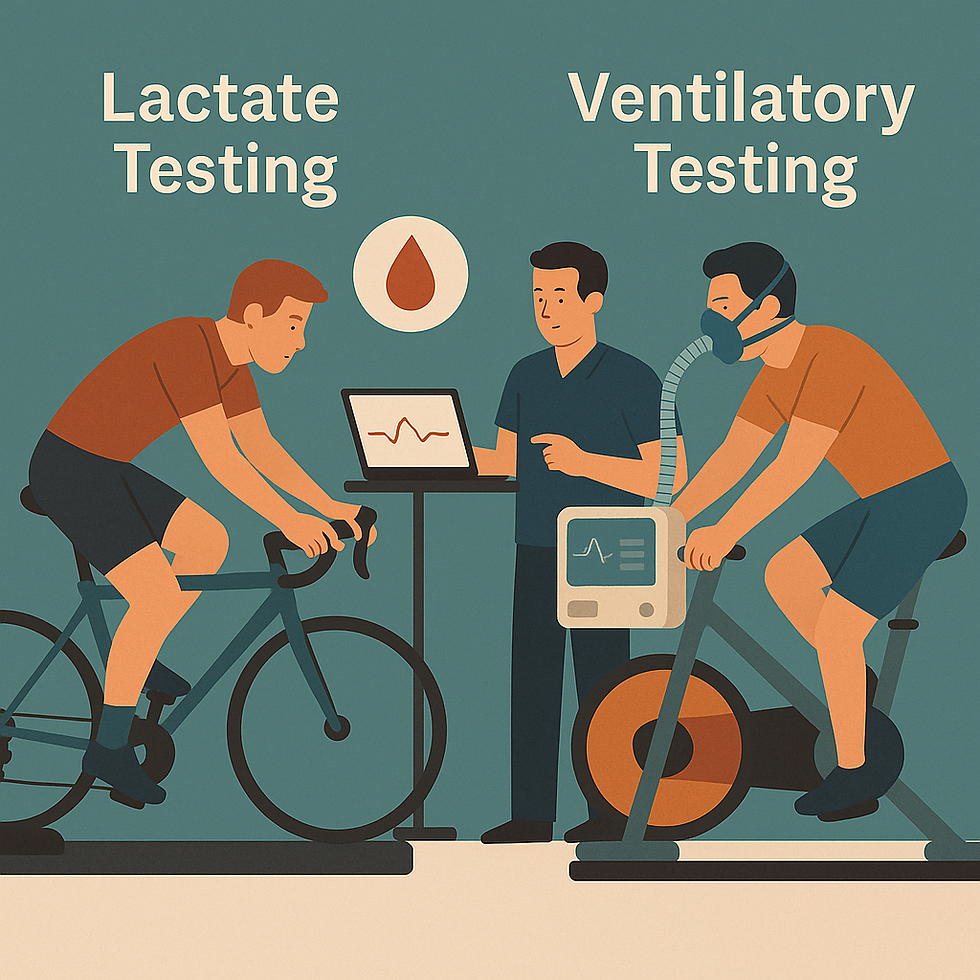Lactate threshold vs ventilatory thresholds: what are the differences and which is more reliable?
- PAIRFS

- 3 days ago
- 3 min read
Why compare these two thresholds?
When discussing training zones, two approaches often come up:
lactate thresholds (measured via blood test)
ventilatory thresholds (measured via respiration)
Many athletes wonder:
Do these thresholds provide the same information?
Is one more accurate than the other?
What purpose do they serve in training?
Which test should I choose to calibrate my zones?
👉 This guide clarifies the differences, advantages and limitations of the two methods.
1. The lactate threshold: a direct metabolic marker
Lactate is a normal product of carbohydrate metabolism. It is measured via a drop of blood taken at each stage of exertion.
✔ Lactate threshold 1 (LT1)
→ first point where lactate rises slightly → marks the lipid → carbohydrate transition → generally corresponds to Zone 2 / active endurance
✔ Lactate threshold 2 (LT2)
→ sharp increase in lactate → accumulation of acidosis → corresponds to the “threshold” intensity (difficult to maintain > 20–40 min)
✔ Advantages
Reliable biochemical measurement
Used in the laboratory
Good indicator of carbohydrate tolerance
✘ Limits
Invasive (blood tests)
Low resolution (one sample every 3–4 minutes)
Sensitive to nutrition (carbohydrates), stress, and freshness
May underestimate or overestimate LT1 if the plateaus are too long
Impossible to measure in real-world conditions (race, climb, free training session)
👉 Very useful in the lab, but not very practical in the daily life of an athlete.
2. Ventilatory thresholds: the “breathing” version of thresholds
Ventilatory thresholds (VT1 / VT2) are detected by observing:
ventilation (VE),
exhaled CO₂,
changes in respiratory dynamics.
✔ VT1 (Ventilatory Threshold 1)
→ measurable increase in CO₂ → deeper breathing → lipid → carbohydrate shift → corresponds to the true Zone 2 point
✔ VT2 (Ventilation Threshold 2)
→ CO₂ explosion
→ progressive hyperventilation
→ marks the onset of acidosis
→ threshold intensity / high intensity
✔ Advantages
Non-invasive
Highly sensitive to metabolic changes
Can be measured in real time
Suitable for indoor and outdoor use, uphill and racing
Ideal for regularly recalibrating areas
Excellent correlation with LT1/LT2
✘ Limits
Requires a reliable respiratory sensor
May be influenced by acute stress (rare, but possible)
Requires a clean curve for perfect reading
👉 This is the most practical and replicable method for the athlete.
3. Key differences between lactate and ventilation
Appearance | Lactate threshold | Ventilatory threshold |
Type of measurement | Biochemical (blood) | Respiratory (CO₂ / VE) |
Invasive | Yes | No |
Continuous measurement | No | Yes |
Context | Lab only | Outdoor + indoor |
Day-to-day stability | Average | Very good |
Link with metabolism | Direct but punctual | Direct and dynamic |
Link with energy sectors | Very good | Excellent |
Threshold detection | Sometimes difficult | Very precise |
Suitable for training areas | Yes, but only occasionally. | Yes + regular follow-up |
4. Why are ventilatory thresholds often more useful for training?
✔ 1. You can measure them often
→ every week if needed
→ without a blood test
→ without cumbersome protocol
→ in your actual training conditions
✔ 2. They reflect the real-time CO₂/acidosis dynamics
→ therefore your energy sectors
→ therefore your true physiological zones
✔ 3. They allow for earlier detection of fatigue
A decrease in VT1 = a sign of metabolic fatigue.
✔ 4. They can even be measured in cyclosportive events, uphill, or on a stationary trainer
→ perfect for adjusting pacing and intensity.
5. Why the two thresholds are very close… but not identical
In physiology:
LT1 ≈ VT1
LT2 ≈ VT2
The correlation is excellent, but not perfectly superimposable, because:
lactate = production of acidosis
ventilation = the body's response to CO₂ and acidosis
👉 Lactate indicates metabolism
👉 Breathing shows the body's reaction to this metabolism
In training practice, breathing is generally easier to read , more sensitive , more frequent , and more representative of actual effort.
6. How ZoneX makes this accessible to everyone
ZoneX real-time measurement:
your expired CO₂,
your ventilation,
respiratory failures,
metabolic transitions,
the evolution of VT1 and VT2.
Result :
You obtain your thresholds without a blood test .
as reliable as a lactate test,
indoors, outdoors, uphill, long session, short session
with automatic detection of your zones.
👉 You can track your thresholds every week.
👉 And adapt your training scientifically.
Conclusion: lactate and ventilation each have their role… but breathing wins out for training
Lactate:
✔ very precise
✘ Not very practical
✘ punctual
✘ difficult to repeat
Ventilatory thresholds:
✔ Non-invasive
✔ very precise
✔ easily repeated
✔ usable in real-world conditions
✔ Perfect for calibrating a training plan
👉 To understand its physiology on a daily basis , ventilatory thresholds are the reference.
👉 To track your progress, calibrate your zones and adjust your training, respiratory analysis with ZoneX is today the most accessible and effective solution .




Comments